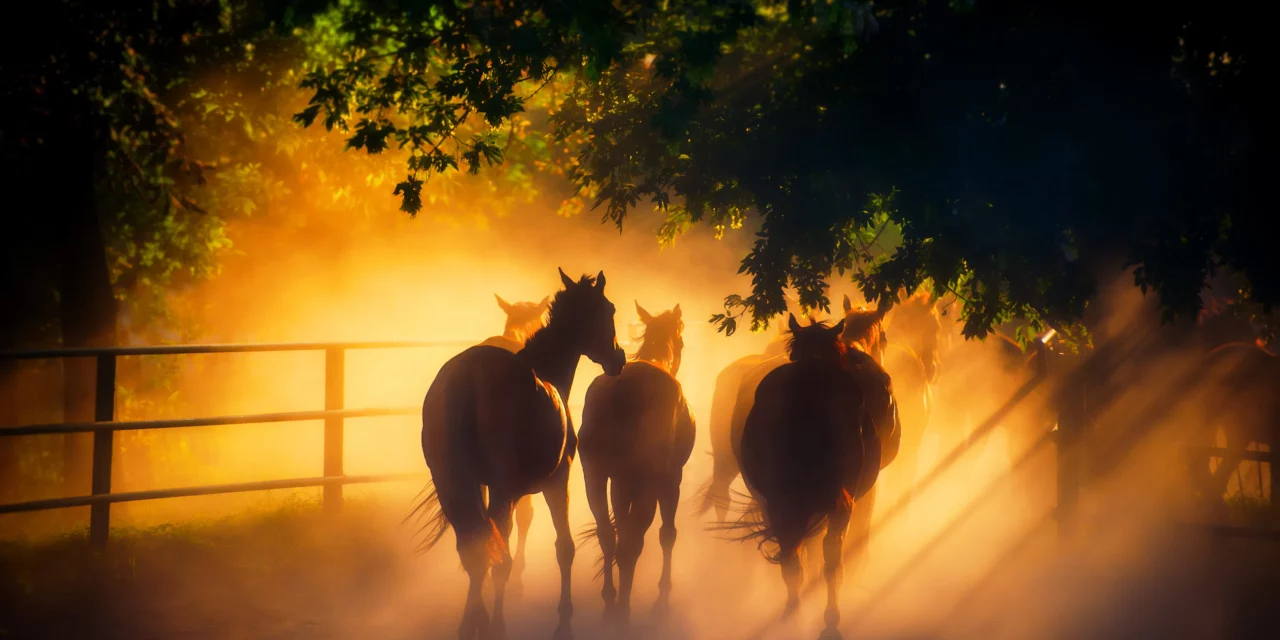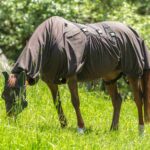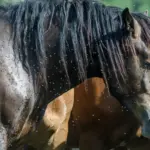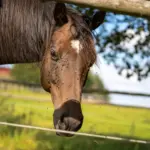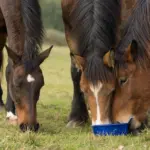Scorching summer days take their toll on horses as well
With the height of summer upon us, the hottest days of the year are just around the corner – and forecasts often predict temperatures well above 30°C in many areas. Horses are generally much more tolerant of temperature fluctuations than we are.
In the steppes, tundras and semi-deserts where horses originally evolved, they’ve adapted to cope with extreme temperature swings – from scorching +40°C days to freezing -20°C nights. Their natural comfort zone lies between -15°C and +25°C, meaning they don’t have to expend much energy regulating their body temperature within this range.
Once temperatures creep above 30°C – especially when horses are left standing in full sun on open pasture – things can quickly become challenging. The horses most at risk are usually the very young and the very old. Foals struggle to regulate their body temperature due to their large surface area compared to body mass. Older horses, particularly those over 20, often have age-related cardiovascular issues, making it much harder for them to cope with extreme heat.
Shelter in extreme heat
For most horses, it’s enough to simply avoid turning them out onto open, unshaded fields during the hottest part of the day. If there’s access to natural shade – such as trees, a wooded area, a field shelter, or a way to move freely between pasture and an open stable – horses will instinctively seek out cooler spots during the midday heat.
It’s ideal if hay nets are available in these shaded areas so the horses can keep nibbling even during longer breaks from grazing. This helps prevent the feeding gaps from becoming too long. Of course, this only works if the shaded space is large enough for all horses in the group to find a spot—especially important in herds where not everyone gets along perfectly.
If there’s pushing and shoving or bullying over access to shaded areas, it can quickly lead to stress—which is particularly dangerous for the cardiovascular system during extreme heat. Lower-ranking horses are especially at risk and may suffer from heat-related colic or even collapse. The best shade is provided by trees, as they still allow a gentle breeze to pass through. Enclosed shelters, such as mobile field stables or three-sided field tents, can become unbearably hot in the sun. It’s no surprise then that some horses prefer to stand in full sun rather than inside. Field shelters should always be designed to allow airflow, so a comfortable climate can be maintained even in hot weather.
If there’s no shade available in the paddocks, it’s best to turn horses out either early in the morning and/or later in the evening, bringing them into a shaded stable during the hottest part of the day. Alternatively, if turnout duration allows, keeping them out overnight and stabling them during the day can be a good solution to avoid the worst of the heat.
If you’re planning to switch turnout to overnight instead of during the day, it’s important to inform horse owners in advance. Many horses don’t sleep as deeply when out at night compared to their usual routine of lying down in the stable for deep sleep. This disruption to their sleep cycle can leave them noticeably overtired the next day—sometimes to the point that they appear sluggish or unwell, which may cause concern for their owners or riders.
Cooling down correctly
If a horse is struggling with the heat, it’s important to provide extra ways for it to cool down. One effective method is to make use of evaporative cooling: wetting the horse’s body allows the moisture to evaporate, which helps lower the body temperature.
To do this, you can hose the horse down—starting at the hooves and slowly working your way up towards the heart—or take the horse for a walk to a nearby stream or lake for a swim.
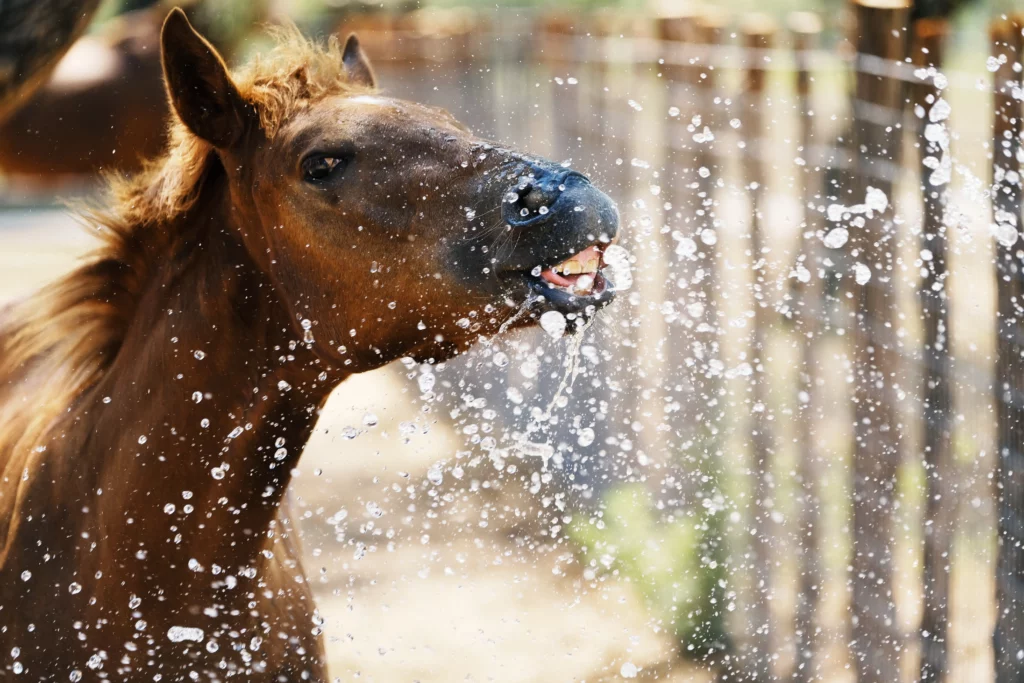
If you don’t have access to a hose or a stream, a bucket of water and a sponge will do the job just as well. This method is more effective than using a plant sprayer, which only creates a fine mist that dries quickly. Ideally, you should wet your horse down around midday, when the heat is at its peak. In the evening, you might rinse off the day’s sweat, but cooling the horse down with water at that time won’t have much benefit, as the temperatures usually drop, and the horse might even start to feel chilly if it gets too cool.
Additional support
If you have a paddock trail, it might be worth considering adding a shallow water wade area for future summers. Many horses love standing in the water to cool off or even turning it into their own personal whirlpool. Here’s a great example: https://www.youtube.com/watch?v=38WJ9eXNviI.
Older horses often struggle to shed their winter coats fully and in time for the hot weather. In these cases, it can really help to give them a bit of a trim with clippers. You usually won’t need to do a full body clip—this is typically only necessary if they’ve almost completely stopped changing their coat. For most older horses, it’s enough to clip a strip along the neck, chest, and possibly the flanks—what’s known as a bib or trace clip https://bilder.markt.de/images/…/pferde/schurarten_pferd.png) to support better temperature regulation. Try to leave the back, especially the kidney area, untouched. If the weather suddenly turns cold or wet again, that area still provides much-needed protection.
Enclosed field shelters
If your only source of shade—whether a field shelter or part of a barn—is a fully enclosed structure, it can quickly become stiflingly hot in warm weather, with the air inside becoming stagnant.
Ideally, you should improve ventilation by modifying the upper sections —removing or shortening a few boards, for example — to create open “windows.” These can be fitted with windbreak mesh during the winter to prevent draughts but left open in the summer to allow fresh air to circulate freely.
As a short-term solution, you can set up one or more fans to get the air moving. However, it’s essential to position them carefully to avoid tripping hazards from cables or any risk of injury from the equipment itself. A good approach is to cordon off a corner of the shelter, place the fans there, and secure the cables along the walls. Horses usually adapt quickly to the sound of the fans, so noise is rarely an issue.
Overheating
If a horse shows signs of overheating – such as excessive sweating, dizziness, unsteadiness, signs of colic, or delayed capillary refill – it’s vital to act immediately. Move the horse into the shade, start cooling it down (hose it with water, ideally place the horse’s legs in buckets of ice water), and contact your vet without delay. Just like in humans, heatstroke in horses can be life-threatening.
To avoid the risk of overheating altogether, it’s best to give horses access to shade during the hottest part of the day – usually between 11 am and 5 pm – and ensure they can nibble on hay while staying cool. Don’t forget to offer water regularly and help the horse to cool down as needed.
Also important in hot weather: electrolyte balance. When it’s hot, horses lose not just water through sweat, but also essential minerals. So always remember: Heat? Think electrolytes! Electrolytes for Horses: Don’t forget the electrolytes

